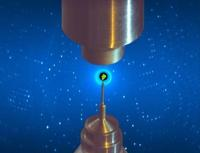Speaker
Description
Clathrin-mediated endocytosis is a crucial cell biology process allowing internalization of many cell-surface proteins, and other cargo, in eukaryotes. Clathrin-coated vesicles (CCVs) are assembled with their cargo at the plasma membrane, then transport to the early endosome inside the cell. A CCV consists of a clathrin scaffold coating a lipid vesicle, in which the cargo is embedded, linked by adaptor proteins that are associated with effectors of CCV assembly, stability and disassembly. It has recently been determined that a single adaptor protein AP2 is sufficient to initiate and drive clathrin-coated bud formation on appropriate membranes, enriched in PtdIns(4,5)P2.
In vivo, AP2 interacts solely with one leaflet of the cellular membrane. Therefore, an alternative valid model system is to explore clathrin assembly on a flat lipid surface (in our case, Langmuir monolayers and solid-supported bilayers). This allows us to probe the system with a set of state-of-the-art characterization methods typical of soft matter and physical chemistry, including neutron reflectometry, interfacial tensiometry and rheology. We thus have been able to analyse the first stages of CCV assembly by using cargo embedded in a lipid monolayer/bilayer.
We show here, in particular, the influence of AP2, and subsequently the clathrin scaffold, on the composition, structure and mechanics of the complex layer that self-assembles in stages.

